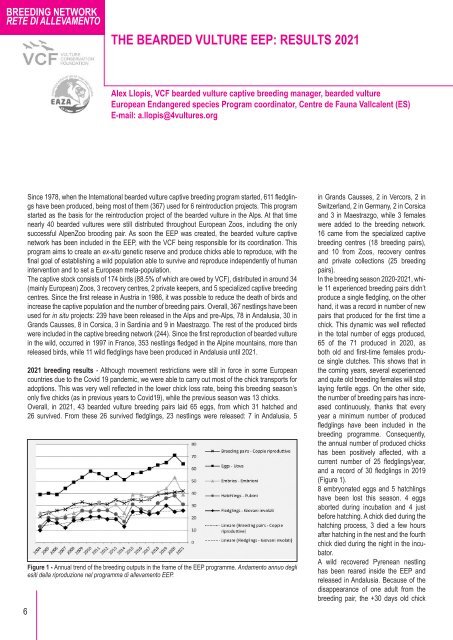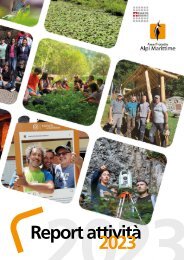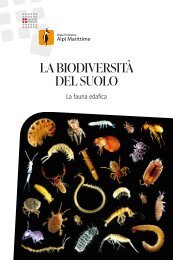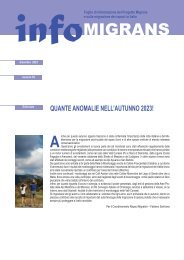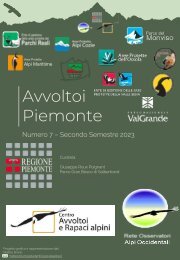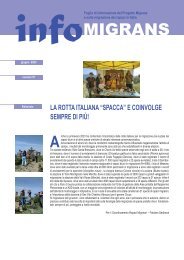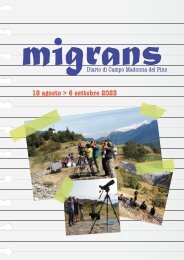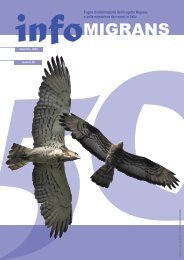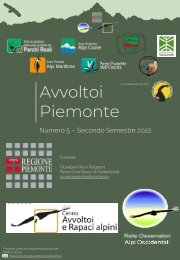infoGIPETO n.38 |dicembre 2021
Periodico d'informazione sul progetto di reintroduzione del gipeto.
Periodico d'informazione sul progetto di reintroduzione del gipeto.
- No tags were found...
You also want an ePaper? Increase the reach of your titles
YUMPU automatically turns print PDFs into web optimized ePapers that Google loves.
BREEDING NETWORK<br />
RETE DI ALLEVAMENTO<br />
THE BEARDED VULTURE EEP: RESULTS <strong>2021</strong><br />
Alex Llopis, VCF bearded vulture captive breeding manager, bearded vulture<br />
European Endangered species Program coordinator, Centre de Fauna Vallcalent (ES)<br />
E-mail: a.llopis@4vultures.org<br />
6<br />
Since 1978, when the International bearded vulture captive breeding program started, 611 fledglings<br />
have been produced, being most of them (367) used for 6 reintroduction projects. This program<br />
started as the basis for the reintroduction project of the bearded vulture in the Alps. At that time<br />
nearly 40 bearded vultures were still distributed throughout European Zoos, including the only<br />
successful AlpenZoo brooding pair. As soon the EEP was created, the bearded vulture captive<br />
network has been included in the EEP, with the VCF being responsible for its coordination. This<br />
program aims to create an ex-situ genetic reserve and produce chicks able to reproduce, with the<br />
final goal of establishing a wild population able to survive and reproduce independently of human<br />
intervention and to set a European meta-population.<br />
The captive stock consists of 174 birds (88.5% of which are owed by VCF), distributed in around 34<br />
(mainly European) Zoos, 3 recovery centres, 2 private keepers, and 5 specialized captive breeding<br />
centres. Since the first release in Austria in 1986, it was possible to reduce the death of birds and<br />
increase the captive population and the number of breeding pairs. Overall, 367 nestlings have been<br />
used for in situ projects: 239 have been released in the Alps and pre-Alps, 78 in Andalusia, 30 in<br />
Grands Causses, 8 in Corsica, 3 in Sardinia and 9 in Maestrazgo. The rest of the produced birds<br />
were included in the captive breeding network (244). Since the first reproduction of bearded vulture<br />
in the wild, occurred in 1997 in France, 353 nestlings fledged in the Alpine mountains, more than<br />
released birds, while 11 wild fledglings have been produced in Andalusia until <strong>2021</strong>.<br />
<strong>2021</strong> breeding results - Although movement restrictions were still in force in some European<br />
countries due to the Covid 19 pandemic, we were able to carry out most of the chick transports for<br />
adoptions. This was very well reflected in the lower chick loss rate, being this breeding season’s<br />
only five chicks (as in previous years to Covid19), while the previous season was 13 chicks.<br />
Overall, in <strong>2021</strong>, 43 bearded vulture breeding pairs laid 65 eggs, from which 31 hatched and<br />
26 survived. From these 26 survived fledglings, 23 nestlings were released: 7 in Andalusia, 5<br />
Figure 1 - Annual trend of the breeding outputs in the frame of the EEP programme. Andamento annuo degli<br />
esiti della riproduzione nel programma di allevamento EEP.<br />
in Grands Causses, 2 in Vercors, 2 in<br />
Switzerland, 2 in Germany, 2 in Corsica<br />
and 3 in Maestrazgo, while 3 females<br />
were added to the breeding network.<br />
16 came from the specialized captive<br />
breeding centres (18 breeding pairs),<br />
and 10 from Zoos, recovery centres<br />
and private collections (25 breeding<br />
pairs).<br />
In the breeding season 2020-<strong>2021</strong>, while<br />
11 experienced breeding pairs didn’t<br />
produce a single fledgling, on the other<br />
hand, it was a record in number of new<br />
pairs that produced for the first time a<br />
chick. This dynamic was well reflected<br />
in the total number of eggs produced,<br />
65 of the 71 produced in 2020, as<br />
both old and first-time females produce<br />
single clutches. This shows that in<br />
the coming years, several experienced<br />
and quite old breeding females will stop<br />
laying fertile eggs. On the other side,<br />
the number of breeding pairs has increased<br />
continuously, thanks that every<br />
year a minimum number of produced<br />
fledglings have been included in the<br />
breeding programme. Consequently,<br />
the annual number of produced chicks<br />
has been positively affected, with a<br />
current number of 25 fledglings/year,<br />
and a record of 30 fledglings in 2019<br />
(Figure 1).<br />
8 embryonated eggs and 5 hatchlings<br />
have been lost this season. 4 eggs<br />
aborted during incubation and 4 just<br />
before hatching. A chick died during the<br />
hatching process, 3 died a few hours<br />
after hatching in the nest and the fourth<br />
chick died during the night in the incubator.<br />
A wild recovered Pyrenean nestling<br />
has been reared inside the EEP and<br />
released in Andalusia. Because of the<br />
disappearance of one adult from the<br />
breeding pair, the +30 days old chick


